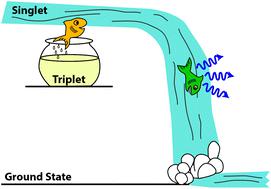当前位置:
X-MOL 学术
›
Mater. Horiz.
›
论文详情
Our official English website, www.x-mol.net, welcomes your
feedback! (Note: you will need to create a separate account there.)
Thermally assisted delayed fluorescence (TADF): fluorescence delayed is fluorescence denied
Materials Horizons ( IF 12.2 ) Pub Date : 2020-03-05 , DOI: 10.1039/d0mh00276c Daniel Sylvinson Muthiah Ravinson 1, 2, 3, 4 , Mark E. Thompson 1, 2, 3, 4
Materials Horizons ( IF 12.2 ) Pub Date : 2020-03-05 , DOI: 10.1039/d0mh00276c Daniel Sylvinson Muthiah Ravinson 1, 2, 3, 4 , Mark E. Thompson 1, 2, 3, 4
Affiliation

|
High luminescence efficiency is a prerequisite for achieving an electroluminescence (EL) efficiency approaching 100% (photons/electrons). Since the EL process involves the formation of both singlet (S1) and triplet (T1) excitons, this requirement can be further refined to be high luminescence efficiency from both singlet and triplet states, or rapid interconversion between them coupled with high luminescence efficiency from either the singlet or triplet states. A common approach to harvesting S1 and T1 excitons in EL is to use a heavy metal-based emitter, relying on the high spin orbit coupling of a metal ion, such as Ir3+, to promote rapid intersystem crossing and mixing of the S1 and T1 states. An alternative to the use of rare elements like Ir to achieve high EL efficiency involves the use of emitters that harvest S1 and T1 excitons via thermally assisted delayed fluorescence (TADF). In this report, we introduce the routes for efficient radiative decay from S1 and T1 states and describe the TADF process in some depth. The kinetics and efficiency of TADF are analyzed as a function of the energy difference between the S1 and T1 and the rates of emission from each state.
中文翻译:

热辅助延迟荧光(TADF):延迟荧光是荧光被拒绝
高发光效率是实现接近100%(光子/电子)的电致发光(EL)效率的前提。由于EL过程涉及形成单重态(S 1)和三重态(T 1)激子,因此可以进一步完善该要求,使其既具有单重态又具有三重态的发光效率,或者它们之间快速相互转换并具有高发光效率来自单重态或三重态。在EL中收集S 1和T 1激子的一种常见方法是使用重金属基发射极,它依赖于金属离子(例如Ir 3+)的高自旋轨道耦合,以促进快速的系统间交叉和混合。小号1和T 1状态。使用稀有元素(例如Ir)以实现高EL效率的一种替代方法是使用通过热辅助延迟荧光(TADF)收集S 1和T 1激子的发射极。在本报告中,我们介绍了从S 1和T 1状态进行有效辐射衰减的途径,并在一定深度描述了TADF过程。TADF的动力学和效率根据S 1和T 1之间的能量差以及每种状态的发射速率进行分析。
更新日期:2020-03-05
中文翻译:

热辅助延迟荧光(TADF):延迟荧光是荧光被拒绝
高发光效率是实现接近100%(光子/电子)的电致发光(EL)效率的前提。由于EL过程涉及形成单重态(S 1)和三重态(T 1)激子,因此可以进一步完善该要求,使其既具有单重态又具有三重态的发光效率,或者它们之间快速相互转换并具有高发光效率来自单重态或三重态。在EL中收集S 1和T 1激子的一种常见方法是使用重金属基发射极,它依赖于金属离子(例如Ir 3+)的高自旋轨道耦合,以促进快速的系统间交叉和混合。小号1和T 1状态。使用稀有元素(例如Ir)以实现高EL效率的一种替代方法是使用通过热辅助延迟荧光(TADF)收集S 1和T 1激子的发射极。在本报告中,我们介绍了从S 1和T 1状态进行有效辐射衰减的途径,并在一定深度描述了TADF过程。TADF的动力学和效率根据S 1和T 1之间的能量差以及每种状态的发射速率进行分析。











































 京公网安备 11010802027423号
京公网安备 11010802027423号